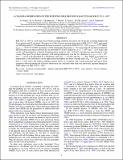A CHANDRA OBSERVATION OF THE BURSTING MILLISECOND X-RAY PULSAR IGR J17511–3057
Author(s)
Paizis, A.; Rodriguez, J.; Wilms, J.; Chaty, S.; Del Santo, M.; Ubertini, P.; Nowak, Michael A.; ... Show more Show less
DownloadPaizis-2012-A CHANDRA OBSERVATIO.pdf (555.3Kb)
PUBLISHER_POLICY
Publisher Policy
Article is made available in accordance with the publisher's policy and may be subject to US copyright law. Please refer to the publisher's site for terms of use.
Terms of use
Metadata
Show full item recordAbstract
IGR J17511–3057 is a low-mass X-ray binary hosting a neutron star and is one of the few accreting millisecond X-ray pulsars with X-ray bursts. We report on a 20 ks Chandra grating observation of IGR J17511–3057, performed on 2009 September 22. We determine the most accurate X-ray position of IGR J17511–3057, α[subscript J2000] = 17[superscript h]51[superscript m]08[s over .]66, δ[subscript J2000] = –30°57'41['' over .]0 (90% uncertainty of 0['' over .]6). During the observation, a ~54 s long type-I X-ray burst is detected. The persistent (non-burst) emission has an absorbed 0.5-8 keV luminosity of 1.7 × 10[superscript 36] erg s[superscript –1] (at 6.9 kpc) and can be well described by a thermal Comptonization model of soft, ~0.6 keV, seed photons upscattered by a hot corona. The type-I X-ray burst spectrum, with average luminosity over the 54 s duration L [subscript 0.5-8 keV] = 1.6 × 10[superscript 37] erg s[superscript –1], can be well described by a blackbody with kT [subscript bb] ~ 1.6 keV and R [subscript bb] ~ 5 km. While an evolution in temperature of the blackbody can be appreciated throughout the burst (average peak kT [subscript bb] = 2.5[+0.8 over –0.4] keV to tail kT [subscript bb] = 1.3[+0.2 over –0.1] keV), the relative emitting surface shows no evolution. The overall persistent and type-I burst properties observed during the Chandra observation are consistent with what was previously reported during the 2009 outburst of IGR J17511–3057.
Date issued
2012-07Department
MIT Kavli Institute for Astrophysics and Space ResearchJournal
The Astrophysical Journal
Publisher
IOP Publishing
Citation
Paizis, A., M. A. Nowak, J. Rodriguez, J. Wilms, S. Chaty, M. Del Santo, and P. Ubertini. “A CHANDRA OBSERVATION OF THE BURSTING MILLISECOND X-RAY PULSAR IGR J17511–3057.” The Astrophysical Journal 755, no. 1 (July 25, 2012): 52. © 2012 The American Astronomical Society
Version: Final published version
ISSN
0004-637X
1538-4357